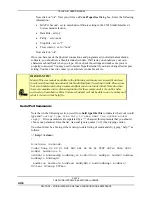
TELOS 2101 USER’S MANUAL
PART IV
THE STUDIO INTERFACE & ADDITIONAL HYBRIDS
IV-87
SECTION 3 – STUDIO INTERFACE: DETAILED CONFIGURATION & REFERENCE
The problem here is that the mic processing combines with the 2101 Studio
Interface’s internal AGC to increase gain in the feedback path. Depending on the mic
processor used, the feedback margin can be reduced by many dB. The Studio
Interface’s internal AGC has an internal adaptive smart-gate function to prevent
inappropriate gain increase, however it is thwarted by this additional processing.
If it is not possible to get an unprocessed mic signal, try to set the mic processor in
such a way that room noise is not “sucked-up” during pauses. You can also try
reducing slightly the output the mic processor (or set the Input Level selection in the
Audio menu to the next higher setting, thereby reducing levels into the unit). The
level to the caller should be ok since the Send AGC will compensate, however you
will force that AGC towards its maximum gain and thereby reduce how much gain it
can add to the feedback path.
•
Try repositioning the mics or speakers. It also helps, of course, to use directional
mics. Customers have reported good results with cardioid mics such the EV RE-20
and the Shure SM-7.
•
Add equalization to the monitor path. Acoustic (and electrical) resonances usually
result in pronounced peaks in the feedback response. Since there are likely to be only
a few pronounced peaks in this response characteristic, flattening out those peaks
with an equalizer can significantly improve the feedback margin. A spectrum
analyzer connected to the output of your mic processor will help detect the frequency
of those peaks.
•
If necessary, soften acoustic room reflections by adding curtains or wall treatments.
The discussion above is intended to help in those situations where open speakers are a
requirement. Whenever possible, of course, it is best to use headphones to listen to the caller
audio. We have found the best scheme is to have the phone monitor speaker mute when the
mic is turned on. If your mix minus has provided a means for the mic signal to be active even
when the mic channel is turned off, the system can be used like a speaker phone when the
taking calls off air. When the call is on the air the speaker mutes, however the talent will
generally be wearing headphones when on mic in any case.


































